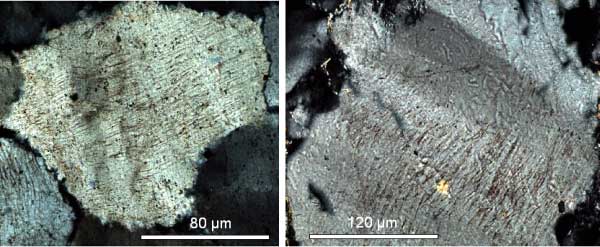PDFs are planar shock deformations in minerals (especially quartz) in the form of closely spaced isotropic lamellae following crystallographic planes (Fig. 1). They may be decorated by fluid and/or mineral inclusions as the result of annealing.

Fig. 1. Planar deformation features in quartz; Ries impact structure. Photomicrograph, crossed polarizers; the field is 460 µm wide.
According to current knowledge, PDFs cannot form in endogenetic geologic processes. Therefore, the occurrence of PDFs plays an important role in the establishment of authentic impact structures. And here, a problem turns out. In the past, curved PDFs have repeatedly been claimed to be of non-impact origin, and we mention for example the paper written by Reimold, W.U. & Koeberl, C. (2000): Critical Comment on: A.J. Mory et al. ‘Woodleigh, Carnavon Basin, Western Australia: A New 120 km Diameter Impact Structure EPSL v. 184, pp. 353-357). In this paper we read:“However, ‘planar’ and ‘locally curved’ represent a contradiction. There are several papers in the literature (e.g. [2,3]) that demonstrate that non-planar lamellae are not shock-diagnostic evidence.”
What are the facts? In general, PDFs in quartz are indeed straight and parallel (Fig. 1) due to crystallographic planes in an undeformed crystal lattice. However, as is well known, quartz crystals may undergo plastic deformations resulting in a deformation of the lattice. In thin section, these deformations are easily seen in the form of undulatory extinction on rotation of the stage of the polarization microscope. Obviously, the crystallographic “planes” in the crystal are no longer plane.
What happens when a shock wave impinges on an already plastically deformed quartz grain to produce PDFs in it? We think that according to definition, the PDFs will develop with respect to the deformed lattice, and, consequently, they must be bent.
What happens when a shock wave impinges on an undeformed quartz crystal to produce straight and parallel PDFs, and the crystal experiences a post-shock plastic deformation? According to the critics of bent PDFs, it’s true the lattice becomes deformed displaying undulatory extinction, but the PDFs must remain straight. As, however, they are no longer following the crystallographic orientation, these PDFs are no PDFs. Everything all right? We to the contrary see things much simpler and predict bent PDFs reflecting the deformation of the crystal lattice.
As an impact may affect a tectonically overprinted target, bent PDFs in pre-shock plastically deformed quartz must not be surprising. On the other hand, bent PDFs from post-shock plastic deformation are expected to develop in the impact cratering process itself (in the excavation and modification stages) not excluding a later tectonic overprint and further bending of PDFs.

Fig. 2. Two sets of slightly bent PDFs in quartz. Photomicrograph, crossed polarizers; the field is about 1.5 mm wide. – Shocked quartzite cobble from crater 004 of the Chiemgau impact strewnfield (see. http://www.chiemgau-impact.com).
We conclude and express (what we have been doing since many years) that curved PDFs (Fig. 2) must belong to the shock inventory of impact structures and that they may even be diagnostic if the bending is correlated with undulatory extinction proving crystallographic orientation. In Fig. 3 we show photomicrographs obtained from the rotation of the stage of a polarization microscope (xx polarizers), and we can clearly observe that the bent PDFs are intimately associated with the undulatory extinction.

Fig.3. Bent PDFs closely corresponding with undulatory extinction of the quartz grain. Photomicrographs taken by stepwise rotation of the stage of the polarization microscope. Same quartzite cobble as in Fig. 2.
In March and April 2000, Dr. Ann Therriault (Geological Survey of Canada, and co-worker of Dr. R.A.F. Grieve) made a very thorough PDF analysis of sedimentary samples from the Azuara impact structure in Spain. She analyzed quartz from a strongly shocked dike-breccia clast and from the Pelarda Fm. ejecta and found among 48 measured PDF sets 9.3 % basal, 40.7 % ω, 12.9 % π, 12.9 % ξ, 7.4 % r,z and subordinate s, x and m PDFs. And Dr. Therriault explicitly stated in her report “… many curved PDFs!!“ (see Fig. 4, and for the PDFs histogram:https://www.impact-structures.com/impact-spain/the-azuara-impact-structure/shock-effects-shock-metamorphism-in-rocks-from-the-azuara-impact-structure/).

Fig. 4. Sets of bent PDFs in quartz; quartzite cobbles from the Pelarda Fm. ejecta of the Azuara impact structure (Spain).
We want to add that meanwhile there are other impact researchers having become aware of peculiar post-shock processes in impact target rocks, and we especially point to an LPSC XXXV (2004) abstract article (http://www.lpi.usra.edu/meetings/lpsc2004/pdf/1730.pdf) on the Charlevoix impact structure. In Fig. 1 of that article nicely bent PDFs in quartz parallel to {0001} are shown (copied to our Fig. 5), and we cite from the text: “Bent planar deformation features (PDFs) can reflect the continuous bending of the crystal lattice (Fig. 1).”

Fig. 5. Bent planar deformation features (PDFs) in quartz from the Charlevoix impact structure. (from Trepmann and Spray 2004).
In fact and strictly speaking, “bent planar deformation features” is a contradiction in terms, but as long as we understand that PDFs refer to the crystal lattice and not to the mathematical definition of a plane, a renaming seems to be dispensable.






































































